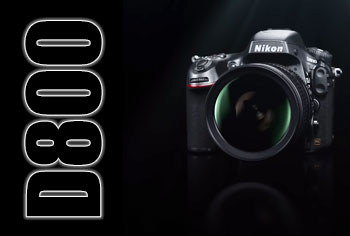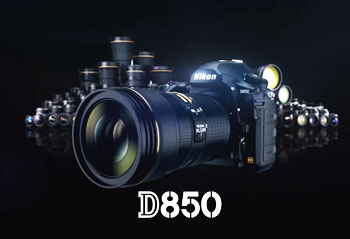The Nikon D800 and D850 are two highly capable, full-frame DSLR cameras aimed at professional and enthusiast photographers. The D800 was released in 2012, while the D850 hit the market in 2017. Both cameras have strengths that may appeal to different users.
This guide examines the key differences between the Nikon D800 and D850 to help you decide which is the best fit for your needs.
Brief Comparison Table
| Features | Nikon D800 | Nikon D850 |
| Sensor Resolution | 36.3MP | 45.7MP |
| Sensor Size | Full-Frame FX | Full-Frame FX |
| Max ISO | 25,600 | 25,600 (102,400 expanded) |
| Autofocus Points | 51 points | 153 points |
| Max Shutter Speed | 1/8000 sec | 1/8000 sec |
| Continuous Shooting | 4 fps | 7 fps (9 fps with grip) |
| Video Resolution | 1080p | 4K |
| LCD Screen | 3.2″ 921k dots | 3.2″ 2.36M dots tilting touchscreen |
| Weight | 900g | 1005g |
Overview of the Nikon D800

The Nikon D800 was a groundbreaking DSLR when it was released in 2012. It features a 36.3MP FX-format (full-frame) CMOS sensor paired with the EXPEED 3 image processor. This delivers incredibly detailed images with vibrant colors and low noise.
The high resolution makes the D800 an excellent choice for landscape, architecture, studio, and other photography where resolving fine details matters most.
Despite the extremely high resolution, the D800 can still shoot at a continuous rate of 4 frames per second. It has a 51 point autofocus system with 15 cross-type points, which provides fast and accurate focusing. The native ISO range is 100-6400, further expandable up to 25,600.
On the video front, the D800 can shoot Full HD 1080p footage at 30/24p. It has headphone and mic jacks for improved audio recording. The camera has a 3.2” LCD with 921k dot resolution and 100% coverage for image framing and playback.
Overall, the D800 was designed to meet the demands of professionals who need high resolution, fast performance, and great low light capabilities.
Overview of the Nikon D850
As the successor to the highly regarded D810, the Nikon D850 sets a new benchmark for full-frame DSLR image quality and performance.
The D850 includes a 45.7MP backside-illuminated (BSI) FX-format sensor without an optical low-pass filter, enabling maximum sharpness and detail retention. The sensor works together with Nikon’s powerful EXPEED 5 processor to create stunning image quality with minimal noise.
Compared to the D800, the D850 has gained Nikon’s improved 153 point autofocus system with 99 cross-type sensors. This covers a large area of the frame andexcel in low light focusing.
Continuous shooting goes up to 7 fps, or 9 fps with the optional battery grip. The D850 also becomes Nikon’s first DSLR to capture 4K UHD video.
The D850 sports a bright optical viewfinder and a tilting 3.2” touch screen LCD with 2.36 million dots resolution. The camera body is weather sealed to resist dust and moisture when shooting outdoors.
Dual card slots allow overflow or backup plus the flexibility of double the storage space. With excellent ergonomics, sophisticated technology and robust construction, the D850 satisfies demanding professionals and enthusiasts alike.
Also Read: Choose Between Sony A1 and A7 IV
Key Differences Between the Nikon D800 and D850
Now let’s dive deeper into the distinctions between these two full-frame Nikon models.
- Image Sensor

The most noticeable difference is in resolution. The D850 provides a 23% increase in megapixels over the D800’s already impressive sensor. 45.7MP versus 36.3MP allows for larger, more detailed prints and extensive cropping flexibility.
In addition, the D850 gains Nikon’s first backside-illuminated (BSI) full-frame sensor. This technology relocates wiring to the back of the light-sensitive photodiodes, improving light capture through the entire frame. BSI sensors provide cleaner high ISO performance.
- Autofocus System
While no slouch in its day, the Nikon D800 houses a 51 point AF system with 15 cross-type points. The D850 brings Nikon’s high-end 153 point system with 99 cross-type sensors and coverage across nearly the entire frame. This provides more accuracy, especially for off-center subjects. The increased number of focus points also benefits tracking moving subjects.
- Continuous Shooting Rate
Thanks to the EXPEED 5 image processor, the D850 can shoot at 7 fps, or 9 fps if using the optional MB-D18 grip. The D800 manages 4 fps continuous shooting, which is decent but slower than the newer D850. The extra speed allows capturing more moments in quick action scenarios.
- ISO Range
On paper, both cameras have a native ISO range of 100-6400 that can be expanded to 25,600. However, there is an advantage to the D850. Due to the BSI sensor and EXPEED 5 processor, the D850 demonstrates less noise and clearer results at higher ISOs. This makes it more usable in low light.
- Video Capabilities
A significant leap comes in video. The D850 offers 4K UHD recording at 30/25/24p, while the D800 maxes out at Full HD 1080p. 4K allows more flexibility for cropping and provides higher resolution for detail. The D850 can also output uncompressed 4K to an external recorder. For professional videographers, the D850 is much more capable.
- Viewfinder/LCD
One handling difference is the D850’s rear LCD adds touch screen capability and tilts for easier operation at difficult angles. However, both cameras have 3.2” LCDs with similar high resolution – the D800 with 921k dots versus 2.36M dots on the D850. A minor change is the D850’s larger 0.75x viewfinder magnification compared to 0.7x on the D800.
Also Watch This Review Video:
- Size and Weight
The D800 weighs in at 900g, while the D850 tips the scales at 1005g. The difference of 105g is noticeable when carrying the camera all day. The D800 will feel lighter during a long shoot or travels. But the D850 is still comfortable for its class of pro DSLR.
- Price
As expected, the D850 retails for around $3299 in comparison to $2497 for the older D800. There is a significant cost increase which may affect budget-conscious buyers. However, the upgrades in resolution, performance, and features justify the higher price point.
Also Read: Comparison Between the Nikon D5500 and D7200
Frequently Asked Questions (FAQs)
Yes, the Nikon D850 is considered better than the D800 overall. The D850 has a higher resolution sensor, improved autofocus, faster burst speed, 4K video, and more modern features. Image quality shows less noise at high ISOs as well. The D850 essentially improves upon the D800 in almost every area.
For many photographers, upgrading from the D800 to the D850 is worthwhile. You gain megapixels for more detail, better low light performance, advanced autofocus, and speed. Upgrading makes the most sense if you need resolution for large prints, use higher ISOs frequently, or want to capture 4K video.
Yes, the Nikon D850 is a highly popular camera for professional photographers. Landscape, wedding, portrait, wildlife, and architecture photographers often rely on the D850. It provides an exceptional combination of resolution, speed, and durability that satisfies pros.
The D810 is a stepped up version of the D800 with a 36MP sensor without an optical low-pass filter for max sharpness. The D810 added an electronic first curtain shutter and upgraded to EXPEED 4. But the D850 eclipses both older models with its 45MP BSI sensor, EXPEED 5 processor, 4K video and 153 point AF system.
Also Read: Differnces Between Nikon D5500 And D7500.
Final Thoughts
The Nikon D800 and D850 are both impressive full-frame DSLRs capable of meeting professional demands. The D850 builds upon the strong foundation of the D800 by increasing resolution, improving autofocus, adding faster burst shooting, and bringing 4K video to Nikon DSLRs.
For many photographers, the superior performance and updated feature set of the D850 is worth the upgrade cost over the still excellent D800. Consider how you shoot and which aspects are most important to make the right choice between these two Nikon flagships.
Either model will provide superb image quality and performance for photographers who need an advanced DSLR they can rely on.

